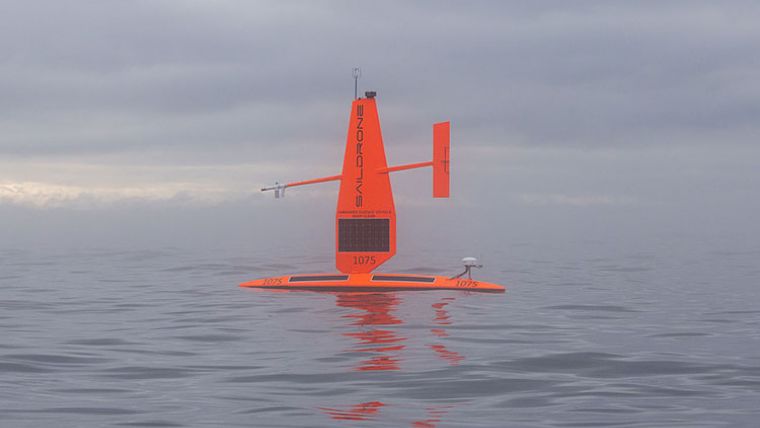Saildrone presents new acoustic capabilities to protect marine mammals
As the demand for clean energy continues to grow, there has been a corresponding increase in the development of offshore wind farms to help meet energy needs. However, it is important that the construction and operation of these sites do not negatively impact marine ecosystems. Many large whale species are highly dependent on acoustics to conduct important life functions, which also makes them sensitive to underwater noise.
Whale vocalizations are often very low frequency, so that they are difficult to detect and easily masked by man-made sounds. Traditional visual and acoustic methods for monitoring marine mammals often use trained biologists, known as PAM (passive acoustic monitoring) operators, who are deployed offshore on vessels, increasing the safety risk to those persons. Additionally, the noise produced by the vessels can make it challenging to detect some marine mammal species.
Saildrone is working with RPS, a leading provider of protected species monitoring and mitigation compliance services, to create a monitoring network using cutting-edge acoustic technology, autonomous vehicles and machine learning to detect, classify and localize marine mammals.
Listening to whales and other mammals
Two Saildrone uncrewed surface vehicles (USVs) equipped with proprietary underwater acoustic systems were deployed off the coast of Massachusetts to listen for North Atlantic right whales and other marine mammals. The virtually silent saildrones were stationed in an area where several species of whales are known to be present. During the two-week deployment, the saildrones recorded numerous marine mammal vocalizations.
Saildrone’s passive acoustics package is a multi-frequency, multi-purpose commercial sensing array meant to detect underwater acoustic phenomena. The sensor selection, frequency selection and spatial arrangement are designed to listen for marine mammals such as whales and dolphins to mitigate impacts on those species from human activities.
The capabilities of Saildrone’s vehicles have been demonstrated with almost 1,000,000 nautical miles sailed and more than 25,000 days at sea in the harshest ocean environments imaginable. Saildrone’s three USV models, the Explorer, Voyager and Surveyor, have been developed to balance mission payload flexibility and endurance.
“This milestone achievement represents a significant step forward in our ability to study and protect whales and other marine mammals,” said Saildrone CTO Brian Hernacki. “Saildrone’s passive acoustic technology allows us to gather vital information in a non-invasive and cost-effective manner and, combined with the mobility and endurance of our uncrewed platforms, provides unprecedented monitoring capability, facilitating research, conservation and commercial enterprise.”
Monitoring whales in real time
Now, RPS’s acoustic scientists have the task of post-processing the data collected by Saildrone, identifying the types of calls detected and the species producing those calls. One of the tools that the analysts will use is RPS’s machine learning tool, Neptune, a predictive algorithm for accurate, reliable detection of marine mammal vocalizations. The advanced acoustic sensors developed by Saildrone, combined with RPS’s AI, will detect and monitor the presence of whales in real time, allowing for proactive measures to be taken.
“The global development of offshore wind is key to moving away from traditional, non-renewable power generation, especially fossil fuels. But development must not negatively impact the marine mammals that share the habitat. Saildrone and RPS are working together to provide a unique, flexible and adaptable solution to marine mammal monitoring of large areas over significant time periods, using smart tools to reduce personnel in the field but without decreasing the monitoring and mitigation provided to protect our marine animal neighbours,” said Stephanie Milne, RPS team leader, US Offshore Renewables.
Offshore wind and wildlife
The project is supported by a large award from the National Offshore Wind Research and Development Consortium (NOWRDC) to facilitate offshore wind’s coexistence with wildlife and other ocean users and support other industry initiatives. “NOWRDC is excited to award projects that directly respond to challenges in the offshore wind industry,” said Lyndie Hice-Dunton, executive director, NOWRDC. “As we approach the deployment of commercial-scale offshore wind in the US, these projects have the potential to provide real solutions to near-term industry challenges – ranging from stakeholder coordination to transmission resiliency. By harnessing the power of technology and innovation, we can strike a balance between sustainable economic development and the preservation of our fragile ecosystems.”
Marine mammal monitoring is not the only technological advancement that Saildrone brings to the offshore wind industry. The company provides the critical ocean data needed to support the entire life cycle of an offshore wind farm, from site assessment and development to construction and operation. Saildrone USVs, powered by renewable wind and solar energy with a minimal or zero operational carbon footprint, provide high-resolution ocean mapping, persistent year-round ecosystem monitoring and maritime security solutions.
By providing accurate and timely information, Saildrone enables developers and operators to make informed decisions that prioritize the protection of marine life. As the offshore wind industry grows, Saildrone’s innovative solutions will play a crucial role in ensuring a sustainable and responsible approach to renewable energy development. This approach could serve as a model for other offshore industries, highlighting the importance of responsible and environmentally conscious practices.















